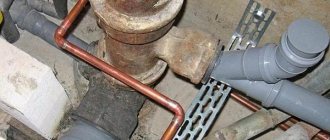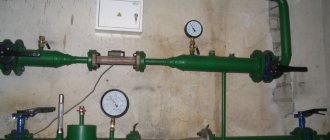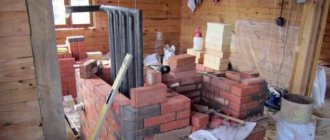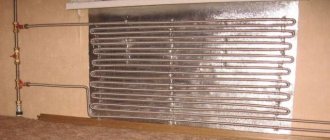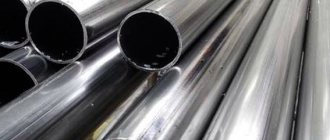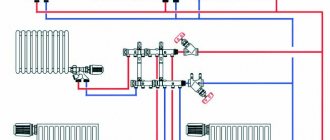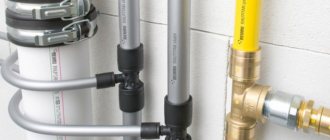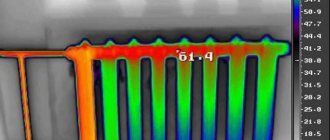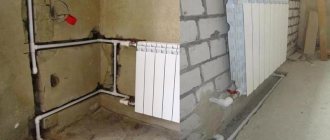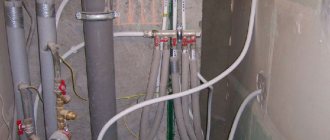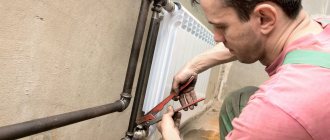Why is corrugation a good option for heating?
Stainless steel corrugation began to be used for heating systems not so long ago, but has already gained popularity due to its unique technical and operational characteristics.
Advantages and disadvantages:
The advantages can be safely attributed to:
- wide range of operating temperatures. Corrugated pipes can be operated with coolant temperatures in the range -50ºС to +110ºС without loss of their original properties;
- resistance to strong pressure surges within the network. Stainless steel products have a large margin of safety in terms of pressure, as they can withstand up to 50 bar. In heating systems at a maximum circulating temperature of +110ºС, the pressure level usually does not exceed 15 Bar;
- high elasticity. Pipes are easily bent without the use of special tools. They can be given any shape (bending radius is 30 - 150 mm depending on the diameter of the pipes), which allows you to assemble the wiring with a minimum number of fittings, thus reducing the overall cost of the heating system;
- unusually high resistance to corrosion. The corrugated pipe does not collapse under the influence of moisture, its internal walls are not subject to the formation of limescale deposits that reduce the throughput of pipelines;
- durability. The service life of corrugated stainless steel pipes is practically unlimited; the service life of the heating system can only be affected by a violation of the integrity of the fittings, the service life of which does not exceed 30 years;
- smooth inner surface of the walls. Corrugated pipes have a smooth surface on the inside, creating minimal resistance to the movement of the coolant and ensuring noiselessness;
- maintainability. If necessary, you can easily replace only a section of a corrugated pipe or a device that has failed;
- the ability to compensate for linear expansion due to the corrugated structure, which is especially important when installing a “warm floor”;
- frost resistance. Stainless steel corrugation is not afraid of defrosting; if water freezes in it, the pipe simply expands, and in the future it can be warmed up with a blowtorch.
Like any other product, flexible heating pipes have some disadvantages:
- low impact resistance. When installing sections of the heating system in places where there is a risk of mechanical damage, it is recommended to protect the corrugated stainless steel pipe with a metal or polymer box;
- difficult care. Cleaning corrugated pipes from dust is somewhat more difficult than pipes with a smooth surface. When cleaning, you will have to use a brush, and it is best to immediately cover the corrugated structures with a protective casing or screen;
- specific appearance. Many people do not consider the corrugated surface of products to be aesthetically pleasing enough, but if you use a hidden installation method, then this drawback becomes insignificant;
- impossibility of concreting inside the wall. To connect to heating devices, special fittings are used, to which free access must be provided for inspection and maintenance;
- high electrical conductivity, so a grounding device and installation of dielectric gaskets are necessary.
Advantages of heating systems with corrugated stainless pipes
Such heating systems have a number of advantages. First of all, due to the material’s resistance to changes in pressure levels and its strength, corrugated stainless steel pipes can be used to install a central heating system that uses bimetallic radiators. In this case, you don’t have to worry that the eyeliner will become one of the weak links of the entire system.
Let us remember that stainless steel is chemically stable. It does not form galvanic steam when interacting with copper and aluminum. This advantage manifests itself in situations where neighbors who are in a common heating circuit replace pipes with copper ones or install aluminum radiators. Corrugated stainless steel pipes will protect both sides from the possible negative consequences of such repairs.
Pipes of this type are easy to install. In terms of installation method, corrugated stainless steel pipes used in heating systems are better than metal-plastic pipes, during installation of which compression fittings are used.
To install a heating system made of corrugated pipes, you will need a minimum set of tools that have already been indicated above: a cutter, a gas wrench or an adjustable wrench. But in some cases you can do without a cutter. In addition, you can assemble one connection in just one minute.
The undoubted advantage of corrugated stainless steel pipes is their long service life. It has virtually no limiting frames and does not shrink even when the design coolant temperature is constantly exceeded.
Note that the limit of 110 degrees Celsius is purely conditional. It is related to what indicators of resistance to elevated temperatures the sealing gaskets have, and what thermal expansion the fittings and pipes have. Stainless steel begins to lose its strength only at temperatures above eight hundred degrees Celsius.
Alternatives
In addition to stainless steel, plastic or cast iron (products with a ribbed surface) are used to make corrugated pipes. Plastic products are not the best option for heating, where the operating temperature of the coolant can reach +110ºС, since they can function normally only at temperatures up to +85ºС and a pressure in the system of no more than 20 atmospheres.
Cast iron finned pipes are characterized by high resistance to thermal loads, but they are gradually falling out of mass use due to their high weight, low impact resistance and complex installation process.
How are corrugated pipes made from stainless steel?
The technical conditions for the manufacture of corrugated pipes regulate the use of AISI 304 stainless steel.
It is produced using the following technology:
- the stainless steel sheet enters the forming machine, where it takes on a cylindrical shape;
- the edges of the cylinder are welded together by laser, plasma or induction current;
- the strength of the weld is checked by eddy currents;
- then the workpiece undergoes calibration, during which the product acquires a characteristic wavy structure;
- When leaving the calibrating machine, cutting to the required length is carried out.
Such a pipe can already be used for installation, but it is less durable and ductile. To increase these indicators, products are subjected to heat treatment (firing) at a temperature of +600ºС, followed by a period of forced cooling (tempering).
Visually, the products are no different, but after firing they become stronger and more flexible, which means that when bent, creases will not form on them, as on unmolded corrugation.
Advantages and disadvantages
And although we are talking about stainless steel, this metal also has its negative sides. But let's start with the advantages.
Advantages
- Such pipes are made from high-alloy steel. The most commonly used grade is SUS (AISI) 304, which is used in the food industry.
- These pipes do not corrode, and colonies of mold and fungi do not form on them. And if you compare them with steel pipes for heating, then it’s just heaven and earth.
- Ease of installation work. To do this, you will need a set of wrenches and certain fittings.
- A stainless steel product can withstand several defrosting cycles.
- Since it is a durable metal, it is too tough for rodents.
- Low specific gravity, which means easy transportation and installation.
- High thermal output of the material.
Corrugated pipe in the heating system
By the way, I would like to return to a maintained temperature. We mentioned the Korean manufacturer, but it has one of the lowest indicators, because European manufacturers guarantee +150°C loads. By the way, even at this temperature nothing happens to the pipe, and this limitation is associated only with the O-rings that are used to connect the pipes. They are designed for such temperature loads.
Attention! For information, on the market you can find O-rings that can withstand temperatures of +300°C.
Flaws
- Under high mechanical loads it is easily deformed.
- High price of the product.
- High price of fittings. By the way, manufacturers of stainless steel heating pipes do not produce fittings.
Stainless corrugated register
Manufacturers and what to look for when purchasing
The bulk of stainless steel corrugations are produced in South Korea by the following companies:
- Lavita is a manufacturer of corrugated stainless steel pipes for heating in the mid-market price segment. There are complaints about the strength characteristics of the walls: when installing fittings, there is a danger of damaging the stainless steel, which subsequently causes leaks. However, this drawback is most likely the result of illiterate installation.
- Corrugated stainless steel pipes for heating from this company are considered the best among similar products. It’s true that their price is several times higher than the cost of corrugations from the previous manufacturer. These models are connected with fittings equipped with thicker O-rings, which provides a more reliable connection.
- Hydrost products are comparable in price to pipes from Lavito, but these products often have factory defects. Leaks at fitting installation sites occur on average in 7% of systems assembled from these pipes.
- Quite high-quality products, but their cost is considered unreasonably high.
When purchasing a corrugated product, you should visually inspect its surface for damage, creases and deformations. The distance between the ridges should be the same size along the entire length of the pipe.
It is also necessary to familiarize yourself with the certificate of conformity, which will confirm the quality and allow you to avoid buying handicraft fakes.
Additional selection criteria depend on the type of corrugation:
- numbered length. The pipe must have a complete set of fittings;
- arbitrary length. It is necessary to check the quality of the cutting line. The edges should be smooth and free of burrs.
Important characteristics of pipes for underfloor heating
Now among building materials there are many options for using various technologies and devices for installing a floor heating system that will operate on water. Despite the fact that this heating method is somewhat more difficult to install than using electric heaters, it is still used and is considered quite popular. One of the main elements of this entire system is the pipe through which the coolant will flow. It must have certain characteristics for the heating to work effectively and correctly.
Corrugated Stainless Steel Pipe
Laying corrugated pipes for heated floors
When choosing a water pipe, the following factors are taken into account:
- main operational characteristics - under what conditions this type of pipe can be used;
- features of the installation work;
- thermal conductivity indicators;
- duration of operational life;
- pipe cost;
- flexibility, since during installation of heated floors the pipe will have to be bent many times;
- protection from oxygen penetration, since this element becomes the main cause of rust formation inside the product;
- manufacturer of the material and its reputation.
The use of corrugated stainless steel pipes in the heating system
Attention! The choice of material for floor heating should be made among those types that are intended specifically for heating, and not for organizing ordinary water supply.
The inner walls of the corrugated stainless steel pipe are smooth
Pipes for underfloor heating systems can be made of various materials. Each type has its own usage and performance characteristics.
Table. Types of pipes for organizing floor heating.
| Type of material used in manufacturing | a brief description of |
| Copper | This is one of the oldest materials that was used to equip heating systems in homes. Copper is distinguished by: - long service life and high strength; - antibacterial properties; — corrosion resistance; — the ability to withstand critical temperature changes (from -100 to +250 degrees) without harm. However, copper pipes are very expensive and also have certain operational limitations. They cannot be used if the water is highly acidic or hard. Such conditions reduce the operational period of pipes by half. |
| Metal-plastic | Very popular and high-quality pipes that can easily compete with copper pipes. The advantages of such pipes: - lower price; — long service life (minimum 50 years); - they do not rust; — chemically inert; - lightweight but durable; — smooth, which is why deposits do not form on the surface from the inside. The main disadvantage is the difficulty of connecting individual elements. Poor quality connections can cause flooding of the room and failure of the heating system. Metal-plastic pipes can withstand temperature fluctuations from -10 to +95 degrees. |
| Polypropylene | Pipes made from this material have a lot of advantages, but still it is far from the most popular material. Advantages of use: - environmental safety; — durability; - cheap. They are rarely used for installing heated floors, as they are inconvenient to use - they have a large bending radius. Also, the material cannot be used at sub-zero temperatures - use only from +15 degrees is allowed. |
| Cross-linked polyethylene | Quite durable material. Chemically inert. It is not afraid of temperature changes, does not scratch or crack. |
corrugated pipe for underfloor heating
There is also another type of pipe for sale for installation of underfloor heating - a corrugated pipe made of stainless steel.
Video - Pipes for heated floors
Which corrugation is better?
Lavita is a manufacturer of corrugated stainless steel pipes for heating in the mid-market price segment. However, this product has complaints from consumers regarding the strength characteristics of the walls: when installing fittings, there is a danger of damaging the stainless steel, which subsequently causes leaks. However, this drawback is most likely the result of illiterate installation.
Hydrosta's products are comparable in price to pipes from Lavita, but often have factory defects. Leaks at fitting installation sites occur on average in 7% of systems assembled from these pipes.
The products of the Meibes company are quite high quality, but their cost is considered unreasonably high.
Corrugated stainless steel pipes for heating Kofulso are considered the best among similar products. It’s true that their price is several times higher than the cost of corrugations from the previous manufacturer. These models are connected with fittings equipped with thicker O-rings, which provides a more reliable connection.
Installation
Corrugated stainless steel pipes for heating are subject to the same laying rules as those used when installing heating systems made of other materials. But the methods of connecting their elements have their own characteristics, which should be given special attention:
Component Assembly
Four Necessary Steps
Instructions:
- We cut the product according to the markings using a pipe cutter.
- We take the coupling in one hand, and the cut edge of the pipe in the other.
- We firmly place the fitting on the product.
Internal structure of the coupling
- We tighten the nut on the coupling with an adjustable wrench , as a result of which the gasket will tightly seal the joint, and the corrugation guarantees its reliability.
Example of a finished ternary connection
Installation rules
There are a few more nuances that should be observed when installing a heating system using corrugated stainless steel pipes:
- Be careful with the cut edges as they are incredibly sharp and can easily cut you.
Sharp edges can cause injury if handled carelessly
- During the installation of a heated floor system, the length of one circuit should not exceed the length of one coil of pipe.
- If you are connecting corrugation to old elements of a steel structure, be sure to install a special filter to prevent rust from entering the new pipeline.
- Do not overuse frequent cycles of bending the corrugated pipe in the same place, this can lead to a break.
- Remember that stainless steel is a conductor of electric current, so make sure that the structure is sufficiently distant from its sources.
- Use only fasteners made of plastic, non-ferrous metals or stainless steel.
Samples of plastic fasteners
- Try to ensure that the corrugation does not come into contact with rusty iron during use. This will significantly extend its service life.
Dimensions and approximate prices
Corrugated pipes in diameters of 15, 20, 25 and 32 mm are produced for the distribution of radiator heating systems and “warm floors”.
Price per 1 running meter different for all manufacturers. For example, an annealed corrugated pipe made of Kofulso stainless steel is sold at the price:
- DN 15 mm - 172 rubles;
- DN 20 mm - 320 rub.;
- DN 25 mm - 399 RUR;
- DN 32 mm - 766 rub.
Connection methods
To connect stainless steel corrugated pipes, a brass compression fitting with a silicone or rubber O-ring is used. The end of the pipe is inserted into it until it stops and tightened with a ring.
When switching from a smooth steel pipe to a corrugated one, the fitting is first attached to the smooth pipe, and then a stainless corrugated pipe is inserted into it.
Flexible radiator connection
A manual rolling machine is used to make flexible hoses for radiators and heaters.
First, a piece of pipe of the required length is cut with a pipe cutter or grinder, and the cut line is carefully cleaned. The pipe is then inserted into the protruding flaring machine onto two corrugated rings to allow the protruding edge to be flared using a hammer. Next, a union nut with a rubber gasket is put on this end of the pipe. Attaching the union nut to the other end is done in the same way.
Warm floor
For laying corrugated pipes in a “warm floor” system, it is recommended to use plastic clips as fastening elements.
Holes for dowels for attaching clamps must be drilled through the insulation layer into the concrete screed.
Installation should begin from the distribution cabinet, connecting one end to the manifold outlet. Next, the pipe is rolled out of the coil and placed between the clips in coils, the distance between which should be 30 cm and at least 20 cm from the walls. After the pipe is evenly distributed throughout the room, its second end is connected to the outlet of the return collector.
Advantages of corrugated stainless steel pipe
Stainless steel corrugated pipe is a relatively new material in plumbing, convincingly proving its superiority over plastic or steel counterparts. It is characterized by ease of installation, strength, reliability and durability.
Using stainless steel corrugation, you can design and implement a hot or cold water supply system, gas pipeline or heated floor in a short time.
Reviews and operating experience
The appearance of corrugated stainless steel on sale is estimated at several years, so there is not much operating experience with it. Reviews on forums are only positive from those who have installed such systems at home, and some negative from specialists who claim that such products have higher resistance to coolant flow. However, none of those who installed a heating system using such pipes required the installation of a more powerful circulation pump. Basically, such a system is connected in houses to a wall-mounted gas boiler and includes the usual wiring from heating devices and “warm floors”.
Regarding quality, Kofulso products deserve more positive reviews than products from other brands.
Areas of application of corrugated stainless steel for heating
Corrugated gas stainless liner
Using this type of stainless steel pipes and fittings, you can perform the following types of work:
- Connecting heating batteries;
- Replacing indoor heating risers;
- Installation of a pipeline from local (heating boilers) or main sources of heat carrier to residential and non-residential heated premises;
- Installation of an additional element of the heating system (for example, an analogue of a heating battery);
- Connection of “warm floors”;
- Pipeline laying;
- Gas pipeline installation;
- Fire extinguishing and air conditioning systems.
Due to their flexibility and strength, they are also used in the chemical, food and pharmacological fields. This is explained by the fact that, unlike plastic pipes, corrugated stainless steel does not lose its properties and diameter even after being squeezed.
